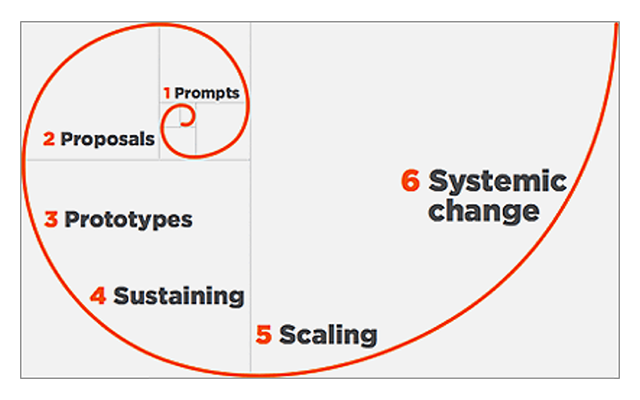INTRODUCTION TO SOCIAL INNOVATION
3.6
Modelling social innovation
There is an ongoing debate, if and to what extent innovation can be managed. A social innovation model is not a recipe for developing or creating more innovation. Instead, the idea is to understand different stages of the innovation process and then deduce consequences to manage the specific phases of the innovation process.
As you can see in the figure below the model developed by Murray, Caulier-Grice, and Mulgan (2010) has the form of a nautilus, emphasizing the growing effects of the different stages. In the following, the stages will be briefly described.

Stages of social innovation developed by Murray, Caulier-Grice, and Mulgan (2010)
1. Prompts, inspirations, and diagnoses
Social problems are not always obvious. Whether something is seen as a social problem is dependent on the societal definition. Something that is accepted at one moment or in one society, might be questioned in the future or in a different country.
In this phase indicators for the need of social change are taken into account. This might be poor performance, insufficient provisions, cost cuts, out-dated processes, etc. These challenges are combined with inspirations – from creativity to latest evidence – in order to tackle the root causes, not only the symptoms.
2. Proposals and ideas
In this phase, we focus on idea generation and solution finding. Using creativity-supporting methods such as design thinking, crowd sourcing, or competitions helps to generate new approaches and perspectives to the problem. Just as in the example of the Gundeldinger Feld, collaboration and participation in this phase is important to prompt social innovation. Combining different logics and perspectives is a creative process that is necessary for innovation.
3. Prototyping and pilots
In this phase, theory meets practice. The developed ideas and concepts have to be tested with prototypes and in pilot projects. Usually, this happens in a smaller setting, so that adaptaitions can be made easily. Learnings and practical understanding often lead to major changes in the concept and just as the prototypes of products, there are many different alternatives have to be tested, in order to find the perfect fit. The duration of this phase can be very different, from just a few weeks to several years.
4. Sustaining
After the proof of concept, the social innovation has to become sustainable. In this phase, the structures and process for a sustainable organization have to be developed. This includes especially governance structures, financial sustainability, and performance measurement. Thus, the business model – profit or nonprofit – has to be defined and the people involved need the right competencies to further develop the organization. In this phase, the founder generation often comes to the point has to decide whether to go on or to find better skilled executives.
5. Scaling and diffusion
So far, social innovation development closely resembles a lot business innovation processes. However, the next step contains a great difference in the question of property rights. For a fast diffusion and scaling of social innovation, open source approaches and collaborative networks are most promising. A second condition for scaling-up is someone who pays. As social innovations address large groups of people instead of individual consumers, a third party such as state institutions or foundations have to pay for the further development.
6. System change
The final stage is system change. Thus, social innovation is part of a social change. However, only few social innovations ever reach this phase as a single action. Instead, many different social innovations – eventually in combination with technological innovations – lead to system change. System change is based on new coalitions, scientific evidence, new laws and norms, or the development of new professions.
Altogether, these phases describe a pragmatic approach to analyze social innovation, but the development is not linear or consequential. Instead, every social innovation has its own dynamic and it is the task of a social initiative manager to allow for this dynamic.
References
Murray, R., Caulier-Grice, J., Mulgan, G. (2010). The Open Book of Social Innovation. London: The Young Foundation & NESTA.
License
University of Basel
